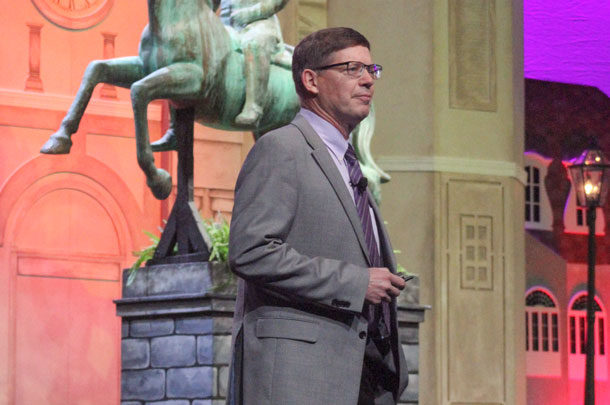Good, a senior analyst at CattleFax, speaking in the annual outlook seminar at NCBA’s annual convention in New Orleans on Jan. 31, said slower numbers do require context for those watching price trends.
“I would challenge us as we go over the next two to three years, thinking about five [prior] years of expansion and expansion possible again this year,” Good said. “At some point, the good things we’ve enjoyed the past few years – a strong domestic economy, strong global trade – they’re going to crumble a bit, aren’t they? At that point in time, we have to be a bit prepared as we go into something different from an environment standpoint, to what we have today.”
The two conditions driving expansion in the beef industry – weather and profitability – have been on the board for five years, Good said. “The cow-calf producer has generally been profitable for five years, and good old Mother Nature has generally smiled upon us.”
Calf crops have increased over the past five years. More inventory is expected to also come into the cull market, as the dairy industry sees more liquidations. And overall cattle-on-feed numbers indicate another 300,000 to 350,000 head in January.
Slaughter and beef production
Good predicted two distinct halves to the year from a price standpoint. Optimism should reign in the first half thanks to the wettest winter on record in 34 years. The calf crop will expand again in 2019, and good moisture and grass will keep the calves out longer off feeders. So more calves, and tighter feedlot supply, in the fall will pinch on the prices. That will encourage lower carcass weights through June.
This trend also leads to lower carcass weights for the feeder supply.
“We are already down 1 percent compared to what you normally expect as we look at January data, and that spread gets wider as you go into the spring.”
Good says that if the first half of the year brings weights down 2 percent more than normal, which is the equivalent of 250,000 head of cattle total, it will offset the increase of cattle on feed for Jan. 1 because of weather.
So with the increase of calves and built-up carcass weights toward the spring, supply will be heavier.
“That tells you what we think about the second half,” Good said. “We feel with bigger cattle-on-feed numbers there’s a challenge of shackle space, and the feeding industry could be a little more uncurrent and more bearish.”
Total slaughter last year was 33 million head, up 460,000 head or 1.4 percent from 2017. That created 500 million more pounds of beef over a year ago. And since 2015, beef production has gone up 3.2 billion more pounds. This reaffirms the need for trade, Good said, since trade markets took 40 percent of the production increase off the domestic market.
That keeps U.S. per capita supplies more manageable and “allowed us to have a market that has stayed elevated from a historical standpoint,” Good said.
Economy factors
Buyers will continue their demand for beef in the coming year, helped by inflationary, domestic and global factors.
Mike Murphy, economic analyst for CattleFax, in addition to outlining several trade issues at play, indicated that the threat of another government shutdown is a potential risk to the country. The presidential Economic Advisory Council says there’s a 0.13 percent impact on GDP each week of a shutdown, and some economics put it as high as 0.25 percent.
Murphy said in addition to a ratification of the trade agreement with Mexico and Canada, the U.S. must watch the U.K.’s pending exit with the European Union. A nasty Brexit wouldn’t affect the beef industry directly, but could make waves for the global economy.
“Anytime you have that kind of uncertainty, it can create some volatility in the marketplace that can spill over into the equity sector specifically,” Murphy said.
Energy is looking favorable for the beef producer heading into 2019, as corrections have taken prices down to below $50 per barrel in some weeks. As the U.S. becomes more energy independent, and can ship more oil overseas, it will keep oil prices stable, with some return to increases in late summer to fall.
Feed, grain and forage
The government shutdown blocked some annual crop production reports from the USDA, but the numbers do show record large cattle on feed. So with exports increasing for U.S. corn (outside of China), Murphy said from a feed perspective that supply is going to be used.
Corn futures should range from $3.60 to $4.10 per bushel, and plantings are expected to go up 2 million acres to 91 million acres, while soybean acres drop 2 million to 87 million.
Murphy predicted a large hay crop going into production for 2019, aided by the Northern Plains, the Southeast and West hitting good production volumes. But hay acres are not expected to change significantly.
Wholesale price outlook
Prices for the U.S. will remain relatively healthy in 2019, Good said, based in large part on solid domestic demand and strong demand in U.S. trade markets.
The U.S. beef export value per head will tick up to $290 per head in 2019, continuing a four-year trend. The urgency will be for more access and solidified deals, especially with Japan in the coming year.
Good sees the market for cattle prices being more explosive in spring than in other years.
Fed cattle will average around $117 per hundredweight (cwt) and fall into a range between $110 to $130.
Cheaper prices will affect feeder cattle in the 750- and 550-pound ranges, as 750-pound cattle average $147, with 550-pound cattle averaging closer to $164. Utility cows come in at $55 for averages, in part by larger culling supplies coming from dairy. ![]()

-
David Cooper
- Managing Editor
- Progressive Cattleman
- Email David Cooper
PHOTO: Kevin Good, analyst for CattleFax, addresses the crowd at the 2019 outlook seminar in New Orleans. Photo by Joy Hendrix.








